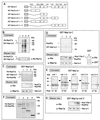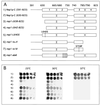The Nsp1p carboxy-terminal domain is organized into functionally distinct coiled-coil regions required for assembly of nucleoporin subcomplexes and nucleocytoplasmic transport
- PMID: 11689687
- PMCID: PMC99963
- DOI: 10.1128/MCB.21.23.7944-7955.2001
The Nsp1p carboxy-terminal domain is organized into functionally distinct coiled-coil regions required for assembly of nucleoporin subcomplexes and nucleocytoplasmic transport
Abstract
Nucleoporin Nsp1p, which has four predicted coiled-coil regions (coils 1 to 4) in the essential carboxy-terminal domain, is unique in that it is part of two distinct nuclear pore complex (NPC) subcomplexes, Nsp1p-Nup57p-Nup49p-Nic96p and Nsp1p-Nup82p-Nup159p. As shown by in vitro reconstitution, coiled-coil region 2 (residues 673 to 738) is sufficient to form heterotrimeric core complexes and can bind either Nup57p or Nup82p. Accordingly, interaction of Nup82p with Nsp1p coil 2 is competed by excess Nup57p. Strikingly, coil 3 and 4 mutants are still assembled into the core Nsp1p-Nup57p-Nup49p complex but no longer associate with Nic96p. Consistently, the Nsp1p-Nup57p-Nup49p core complex dissociates from the nuclear pores in nsp1 coil 3 and 4 mutant cells, and as a consequence, defects in nuclear protein import are observed. Finally, the nsp1-L640S temperature-sensitive mutation, which maps in coil 1, leads to a strong nuclear mRNA export defect. Thus, distinct coiled-coil regions within Nsp1p-C have separate functions that are related to the assembly of different NPC subcomplexes, nucleocytoplasmic transport, and incorporation into the nuclear pores.
Figures






References
-
- Bailer S M, Balduf C, Katahira J, Podtelejnikov A, Rollenhagen C, Mann M, Pante N, Hurt E. Nup116p associates with the Nup82p-Nsp1p-Nup159p nucleoporin complex. J Biol Chem. 2000;275:23540–23548. - PubMed
Publication types
MeSH terms
Substances
LinkOut - more resources
Full Text Sources
Molecular Biology Databases
Research Materials
